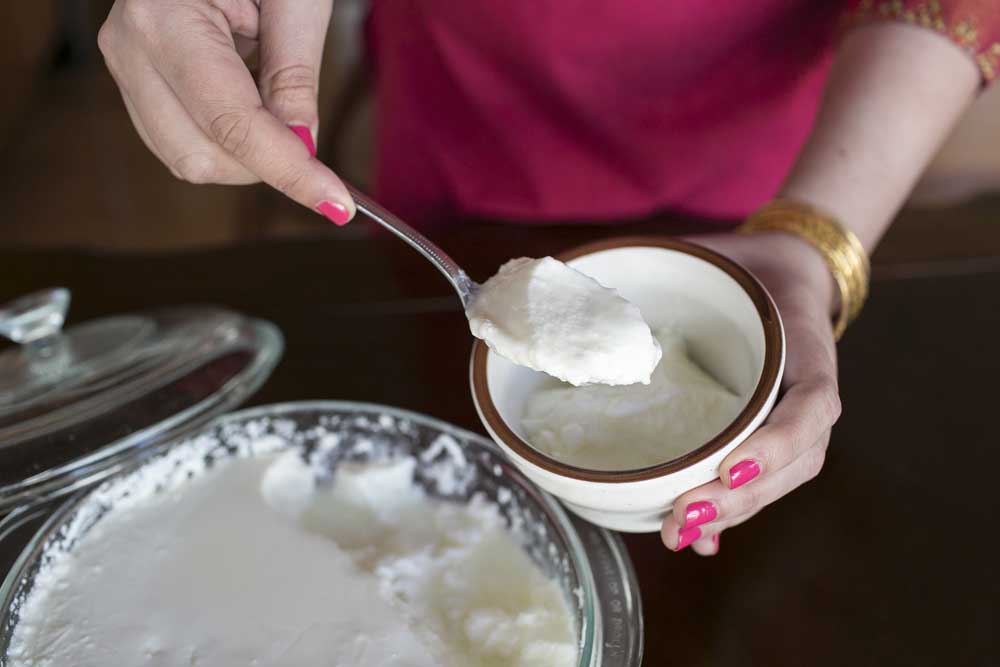For South Asian cooks, starter for making yogurt is an heirloom
Published 12:00 am Wednesday, February 27, 2019

- Pooja Makhijani scoops homemade yogurt into a serving dish. (Nicole Crain/The New York Times)
One of the oldest items in my childhood home in Dallas is a yogurt culture. By my father’s estimate, it has been around for 25 years and seven months.
My dad started making yogurt when he and my mother immigrated to America from Delhi, India, in 1980. He has perpetuated the same culture — the bacteria that kick-start the fermentation process — ever since 1992, by saving a bit of the previous batch of yogurt to create the next one.
Trending
Yogurt is central to many of the world’s cuisines. But in South Asia, where geographical divisions run deep, it is one of the few ingredients that figure prominently in the cooking of nearly every region, from the subtle, vegetable-heavy foods of Gujarat in western India, to the light gravies and fragrant biryanis of Sindhi food in Pakistan.
But for many South Asians who have emigrated, the most important element is the starter culture — the ingredient that not only gives each yogurt its unique, familiar flavor, but also allows yogurt makers to preserve and perpetuate their heritage across time and space.
Pooja Makhijani, 40, who works in communications for Princeton University, said her mother’s yogurt culture is “almost like the tracing of her journey.”
“The yogurt that will be served at dinner tonight was also here the day she landed in the United States” from Pune, India, in 1977, Makhijani said. “Her own narrative is encased in this.”
Families will go to great lengths to keep that narrative going.
Hetal Vasavada, San Francisco author of the cookbook “Milk & Cardamom,” said that when her grandmother first came from Gujarat, India, in 1991 to live with her family in Bloomfield, New Jersey, she tucked some yogurt from home into the folds of her sari blouse and sneaked it through customs.
Trending
Vasavada’s mother had done something similar when she arrived in 1986: She wrapped a tiny container of yogurt in carbon paper, believing that an airport X-ray machine couldn’t detect it. She got it through security, and the family is still using that culture.
Antara Sinha’s family moved around frequently in the United States. They had been given a culture by an Indian couple in Tyler, Texas, when they immigrated in 1994. “It is a community thing,” Sinha said. “A way of saying, ‘You are one of us; we will help you out.’”
But accidents can happen. If you don’t keep your culture going, it can go bad.
Manisha Annam, 48, a Dallas real estate agent who brought her culture to the United States from Pune in 2000, recently went on vacation for several weeks. When she came back, her yogurt had turned rancid. She had to revert to using a store-bought culture.
“I was so upset, you could not believe it,” she said. “Nobody in my family liked the taste. Everybody was complaining.” Eventually, she was able to borrow some culture from a friend.
Why go to all that trouble? Some people just like the consistent taste of yogurt made with their own culture.
“It is that full mouth feel,” Vivek Surti, 33, managing partner at Indian-inspired restaurant Tailor, in Nashville, Tennessee, said of his mother’s yogurt. “It is still sour, but it has this milky quality that coats all of your mouth. When you eat something spicy and you need relief, this is the yogurt that delivers that.”
The South Asian love affair with yogurt can be traced back to 3500 B.C., when it was first consumed by the Indus Valley civilization, in what is now part of western India and Pakistan. But sometime between 1500 and 500 B.C., it became a staple food among the Vedic Aryans, pastoral people who raised buffaloes and cows, said Pushpesh Pant, a historian and author of “India: The Cookbook.”
Yogurt, which was probably discovered after milk had accidentally curdled, was a highly practical dairy product: It had a long shelf life; its cooling properties helped people tolerate warm climates; it could tenderize meat when used as a marinade; and it aided digestion.
Because of this, Pant said, yogurt was considered sacred and pure. In Hindu folklore and ancient poetry, yogurt is frequently mentioned. A spoonful of sweetened yogurt is considered good luck.
To many who enjoy it, it’s a cure-all. “If anything went wrong, I was given yogurt,” said Naz Deravian, 46, Iranian-American author of 2018 cookbook “Bottom of the Pot.” “Burns or cuts, hair growth, skin. My boyfriend broke up with me? Have some yogurt.”
Pant theorized that the thickness and tanginess of South Asian homemade yogurt result from the types of bacteria used. The strains in many Western yogurt brands are chosen to produce milder-tasting, more homogeneous curds. South Asian yogurt is typically made with a more acidic culture, the descendant of a yogurt that was originally created by curdling milk.
More important than the yogurt itself, a long-lived starter culture can become an heirloom, the physical representation of a lineage that can be passed on to future generations.
Sumayya Usmani, 46, a food writer in Glasgow, Scotland, whose family is from Karachi, Pakistan, said making yogurt from scratch “is the closest way that I feel the memories associated with my mom. Now I am teaching my daughter how to do it. It is a dying skill.”
Usmani has a point. Now that commercial yogurt is widely available at grocery stores, some younger people have no interest in continuing their families’ tradition, even if they feel sentimental about it.
Chetna Makan, author of the recently published cookbook “Chetna’s Healthy Indian” and a former contestant on “The Great British Bake Off,” said she gave up on making yogurt after her first attempt wouldn’t set because her home in Kent, England, was too cold.
She conceded that her store-bought yogurt was “bland, like a thick gloop,” unlike her mother’s, which she ate while growing up in central India. But as a working parent, she would rather spend her limited time making other dishes from scratch.








